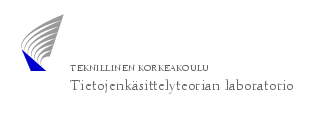T-79.5102
Special Course in Computational Logic (4 cr) P V
Autumn 2007
This course provides an in-depth introduction to answer set programming (ASP) — a constraint programming paradigm that emerged in the 90s. The paradigm is based on a new interpretation of rules: a set of answer sets is associated with each set of rules viewed as constraints. The idea is that a problem at hand is solved by first describing its solutions using rules so that a tight correspondence of answer sets and solutions is obtained. Then, the solution(s) of the problem can be searched for using special-purpose search engines called answer set solvers.
The success of ASP is much due to efficient answer set solvers
available today
(see e.g.
SMODELS,
DLV, and
CLASP).
Moreover, the expressive power of rules strictly exceeds that of
propositional clauses, i.e., the input language of SAT solvers, which
favors succinct representations knowledge in a number of domains. A
wide range of applications of ASP as emerged as a result of solving
challenging computational problems using ASP techniques. In this
respect, it is worth mentioning application domains such as
- product configuration,
- solving combinatorial auctions,
- verifying contingency plans for the space shuttle,
- information and data integration, and
- the analysis of security protocols.
The aim of the course is to familiarize students with the art of declarative problem solving, knowledge representation, and reasoning in the context of ASP. The course introduces ASP, its theoretical background, basic methodology, applications, as well as tools. Moreover, practical programming skills are sought for. The course spans over the first two periods and it consists of a lecture and a tutorial every week. The course requirements include an exam and three compulsory home assignments. Each of them will involve declarative problem solving using methods and tools presented during the course.
- Course material: lecture notes and articles.
- Supplementary reading: Chitta Baral: Knowledge Representation, Reasoning, and Declarative Problem Solving. First edition. Cambridge University Press, 2003.
- Lectures: Mondays, 12—14, room TB353; the course starts on the 17th of September, 2007
- Tutorials: Tuesdays, 15—16, room TB353
- Lecturer:
Docent, D.Sc.(Tech.) Tomi Janhunen,
email
Tomi.Janhunen
 tkk.fi,
home page at http://www.tcs.hut.fi/~ttj/
tkk.fi,
home page at http://www.tcs.hut.fi/~ttj/
- Course assistant:
M.Sc.(Tech.) Antti Hyvärinen,
email
Antti.Hyvarinen
 tkk.fi
tkk.fi
- Prerequisites: T-79.3001 Logic in computer science: foundations
- Home page of the course: http://www.tcs.hut.fi/Studies/T-79.5102/
An Example
| An ASP formulation of the sudoku puzzle: |
The first solution found by SMODELS
(in 0.05s): |
|||||||||||||||||||||||||||||||||||||||||||||||||||||||||||||||||||||||||||||||||||||||||||||||||||
|
|
|||||||||||||||||||||||||||||||||||||||||||||||||||||||||||||||||||||||||||||||||||||||||||||||||||
| Gordon Royle's 16-clue sudoku with two solutions |
